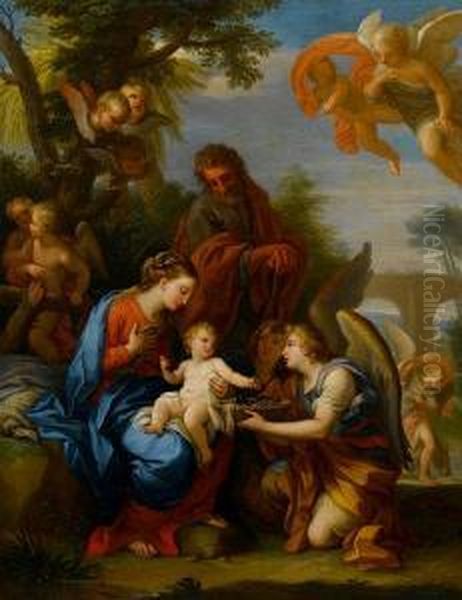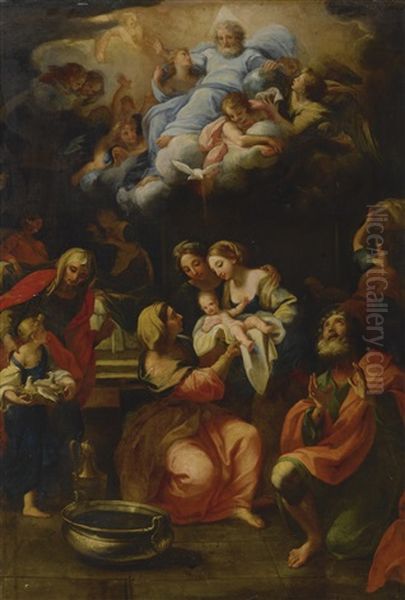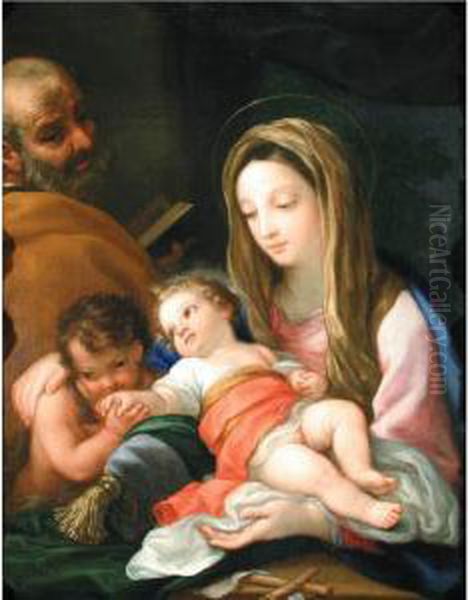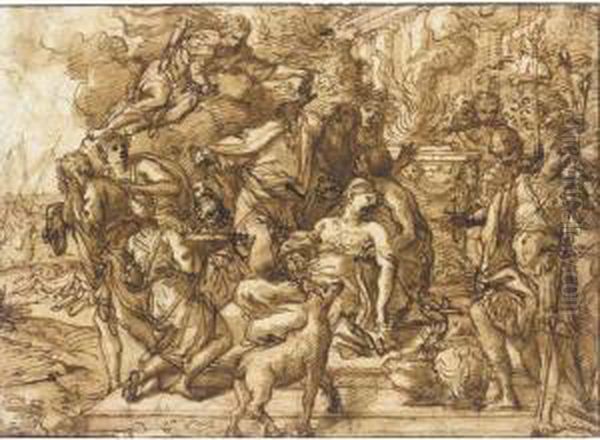Bartolomeo Giuseppe Chiari (1654–1727) stands as a significant, if sometimes overlooked, figure in the vibrant artistic landscape of late seventeenth and early eighteenth-century Rome. A prominent painter of the late Baroque period, his career unfolded during a time of transition, as the high drama of the Baroque gradually gave way to the lighter, more graceful sensibilities of the Rococo. Chiari, a distinguished pupil of the celebrated Carlo Maratta, carved out a successful career, known for his technical skill, his adherence to classical principles, and a distinctive sweetness and refinement in his artistic expression. His oeuvre, encompassing large-scale frescoes, altarpieces, and easel paintings, primarily on religious and mythological themes, adorned numerous churches and palaces in Rome, leaving a lasting mark on the city's artistic heritage.
Early Life and Artistic Formation
The precise birthplace of Bartolomeo Giuseppe Chiari remains a point of minor scholarly debate, with sources suggesting either Rome or Lucca. Regardless of his exact origins, his artistic destiny was forged in Rome, the undisputed center of the art world at the time. The most formative influence on the young Chiari was his apprenticeship under Carlo Maratta (also spelled Maratti), the leading painter in Rome during the latter half of the 17th century. Maratta's studio was a crucible of talent, and Chiari emerged as one of his most devoted and accomplished pupils.
Maratta (1625-1713) was the heir to the classical tradition of Roman painting, tracing its lineage back through Andrea Sacchi to Annibale Carracci and Raphael. He championed a style characterized by clarity, balanced composition, idealized figures, and a rich but controlled palette. This "grand style" was seen as a corrective to the more exuberant and theatrical tendencies of High Baroque artists like Pietro da Cortona or Gian Lorenzo Bernini (though Bernini was primarily a sculptor and architect, his influence on the visual arts was pervasive). Chiari absorbed these lessons thoroughly, mastering the fundamentals of drawing, composition, and color under Maratta's tutelage. His early works, understandably, bear the strong imprint of his master's style.
Ascent in the Roman Art World: Early Commissions

Chiari's independent career began to take shape in Rome. One of his earliest documented, though now lost, commissions was for frescoes in the Casino Chigi alle Quattro Fontane. This project, undertaken for a prominent Roman family, indicates his growing reputation.
A significant early achievement, demonstrating his burgeoning talent, came when he was just twenty-two years old. Around 1676, he was entrusted with painting the frescoes in the side archways of the Marcaccioni Chapel in the church of Santa Maria del Suffragio. These depicted the Birth of the Virgin and the Adoration of the Magi. The latter subject, the Adoration of the Magi, was one he would revisit, notably creating a version for a chapel in St. Peter's Basilica, a testament to the esteem in which he was held. His work in Santa Maria del Suffragio showcased his command of complex multi-figure compositions and his ability to imbue religious narratives with a sense of grace and piety.
Further commissions followed, solidifying his position. He executed ceiling frescoes for the Marchionni Chapel in Santa Maria in Cosmedin, a historic church in Rome. He also contributed to the decoration of rooms in the Palazzo Barberini, one of Rome's most magnificent private residences. For the Barberini, he painted scenes based on Ovid's Metamorphoses, including a work titled Ovid's Village and the Marchetti Villa, demonstrating his versatility in handling both sacred and profane subjects. These mythological paintings allowed for a display of sensuous figures and idyllic landscapes, themes popular with aristocratic patrons.
Mature Style: Refinement and Individuality
While deeply indebted to Carlo Maratta, Chiari gradually developed his own distinct artistic personality. His style is often described as "sweet" and "delicate," characterized by a softer modeling of forms, a lighter and more luminous palette, and a particular grace in the depiction of figures, especially female nudes and cherubic putti. This refinement distinguished his work from the more robust classicism of Maratta, and in some respects, prefigured the emerging Rococo sensibility.
His figures often possess an elegant languor, and his compositions, while well-ordered, can exhibit a gentle dynamism. He excelled in creating harmonious groupings and in conveying tender emotions. The influence of Maratta remained evident in the underlying classicism and the careful drawing, but Chiari infused this framework with a more personal, lyrical quality. He was a master of capturing subtle expressions and gestures, bringing an intimate touch even to grand compositions.

Other painters active in Rome during this period, or whose influence was felt, included figures like Baciccio (Giovanni Battista Gaulli), known for his breathtaking illusionistic ceiling frescoes such as the nave vault of Il Gesù, and Andrea Pozzo, another master of quadratura and illusionism, famously demonstrated in Sant'Ignazio. While Chiari's work did not typically aim for such overwhelming trompe-l'oeil effects, he operated within this visually rich environment. His contemporary, Giuseppe Passeri, was also a pupil of Maratta, and at times, they collaborated. Francesco Trevisani, another prominent Roman painter of the era, shared with Chiari an elegant and refined style, and their works are sometimes found in the same collections.
Key Representative Works
Several paintings stand out as representative of Chiari's mature style and thematic concerns.
Bathsheba at Her Bath (circa 1700): This is perhaps one of Chiari's most famous easel paintings. The subject, drawn from the Old Testament, depicts Bathsheba attended by her servants as King David observes her from afar. It provided an opportunity for Chiari to display his skill in rendering the female nude, a subject he approached with characteristic delicacy and sensuousness. The composition is elegant, the figures gracefully posed, and the colors are rich yet harmonious. The work clearly shows Maratta's influence in its classical underpinnings but also Chiari's own softer, more refined touch, leading some art historians to see it as a precursor to Rococo aesthetics.
Rest on the Flight into Egypt (1719-1720): This painting exemplifies Chiari's handling of tender religious themes. The Holy Family is depicted resting during their journey, often accompanied by angels. Chiari's treatment would have emphasized the humanity and intimacy of the scene, rendered with his typical gentle palette and graceful figures. Interestingly, this work was once misattributed to a certain Fabrizio Chiari, but scholarly consensus now firmly assigns it to Giuseppe Bartolomeo Chiari, highlighting the importance of connoisseurship in art history.
Madonna and Child with Saint Catherine and the Little Angel (circa 1684): An earlier but significant work, this large oil painting showcases Chiari's ability to create complex and emotionally resonant religious imagery. The interaction between the Virgin, the Christ Child, Saint Catherine (likely of Alexandria, identifiable by her attributes), and the playful angels would be rendered with a sweetness and devotion characteristic of his style. The composition would likely be balanced and harmonious, reflecting his Marattesque training.
The Glory of St. Clement: Chiari was also a skilled fresco painter, and one of his major commissions in this medium was the ceiling of the Basilica di San Clemente in Rome, depicting St. Clement in Glory. Executed between 1714 and 1719, this work demonstrates his ability to handle large-scale compositions designed to be viewed from below, filling the space with dynamic figures and celestial light, all hallmarks of Baroque ceiling decoration.

Prophet Isaiah: For the Basilica di San Giovanni in Laterano, the cathedral of Rome, Chiari painted an oval canvas of the Prophet Isaiah. This would have been part of a larger decorative scheme, likely featuring other prophets or biblical figures by various artists, a common practice in major Roman churches. Such a commission underscores his high standing.
Other notable works include The Triumph of Aurora and Apollo and The Legend of Hope, both mythological or allegorical subjects that allowed for imaginative compositions and a display of classical erudition. He also painted frescoes in the church of Santa Maria del Monte (likely Santa Maria ai Monti) and Santa Maria del Suffragio (beyond the early works, possibly later contributions or a misremembered reference to Santa Maria dell'Orto or another church with a similar name, as Santa Maria del Sorologo is not a standard church name in Rome).
The Accademia di San Luca and Official Recognition
Chiari's success and reputation were formally recognized by his peers. In 1697, he became a member of the prestigious Accademia di San Luca, Rome's official academy of artists. Membership in the Accademia was a mark of distinction and provided artists with a network of colleagues, patrons, and students.
His involvement with the Accademia deepened over time. From 1722 to 1725, he served as its Principe (Director or President), a position of considerable honor and responsibility, previously held by his master Carlo Maratta and other luminaries of Roman art such as Domenico Guidi and Charles Le Brun (though Le Brun was primarily active in France, his influence and connections to Rome were significant). This role involved overseeing the Accademia's activities, including its teaching functions, exhibitions, and the upholding of artistic standards. His election to this post signifies the high esteem in which he was held by the Roman artistic community.
Patronage: The Church and Nobility
Like most successful artists of his time, Chiari relied on a network of patrons. The Church was a primary source of commissions, and he executed numerous altarpieces and frescoes for Roman churches, as detailed above. These works served to decorate sacred spaces and instruct the faithful, conveying religious narratives with clarity and emotional appeal.

He also enjoyed the patronage of prominent Roman noble families, such as the Chigi, Barberini, and notably the Colonna family. For these aristocratic patrons, he produced easel paintings, often on mythological or allegorical themes, as well as decorative frescoes for their palaces. These works often carried layers of meaning, sometimes alluding to the virtues or lineage of the patrons themselves. For instance, his decorations in the Palazzo Colonna are noted for emphasizing secular virtues and heroic themes, reflecting the family's status and aspirations. This ability to cater to the diverse tastes and requirements of both ecclesiastical and secular patrons was crucial to his success. The patronage system of the time meant that artists like Chiari often worked closely with patrons who had specific iconographic programs in mind, reflecting the intellectual and cultural currents of the era.
Later Career and Final Works
Chiari remained active into his later years. His style, while rooted in the late Baroque, continued to exhibit the refinement and elegance that characterized his mature work. He maintained a busy studio, and his paintings were sought after by collectors both in Italy and abroad.
One of his last recorded works is the painting of the Holy Family for the church of Santa Maria alle Fornaci. This commission, undertaken towards the end of his life, suggests his enduring reputation and his continued dedication to religious art. The theme of the Holy Family was a popular one, allowing for tender and intimate portrayals, which would have suited Chiari's gentle style.
Bartolomeo Giuseppe Chiari died in Rome in 1727. He was buried in the church of Santa Susanna, a final resting place in the city that had been the stage for his entire artistic career.
Artistic Style: Evolution and Characteristics
Chiari's artistic journey reflects the broader evolution of Roman painting in the late 17th and early 18th centuries. His foundation was the classicizing Baroque of Carlo Maratta, emphasizing clear drawing, balanced composition, idealized forms, and a rich, harmonious palette. Maratta's influence provided a strong structural and intellectual framework for Chiari's art.
However, Chiari's personal sensibility led him towards a greater softness, delicacy, and "sweetness" (dolcezza) in his execution. His use of chiaroscuro (the play of light and shadow) was typically less dramatic than that of earlier Baroque masters like Caravaggio or even some of his more forceful contemporaries. Instead, he often favored a more diffused light that gently modeled his figures, enhancing their grace. His color palettes tended to be luminous, often incorporating pastel shades alongside richer tones, contributing to the overall elegance of his works.
This refinement, the graceful elongation of figures, and the charming depiction of putti and female figures, all point towards the emerging Rococo style. While Chiari never fully embraced the frivolity or asymmetry that would characterize French Rococo under artists like Jean-Antoine Watteau or François Boucher, his work certainly shares the Rococo's emphasis on elegance, charm, and a lighter touch. In this sense, he can be seen as a transitional figure, bridging the grandeur of the late Baroque with the more intimate and decorative qualities of the Rococo. Italian artists who more fully developed a Rococo style include Sebastiano Ricci and the great Venetian master Giovanni Battista Tiepolo, though their regional inflections differed from the Roman school.
Pupils and Workshop
As a successful and respected master, Chiari would have maintained an active workshop and trained a number of pupils. The master-pupil relationship was central to artistic education at the time, with students learning by copying the master's works, assisting with commissions, and gradually developing their own skills.
Among Chiari's documented pupils are:
Pietro Bracci (1700-1773): Although primarily known as a highly successful Rococo sculptor (his most famous work is the colossal statue of Oceanus in the Trevi Fountain), Bracci initially studied painting with Chiari. This early training in drawing and composition would have been valuable for his later sculptural career.
Bernardo Vincenzo Fergoni: An artist noted for his skill in using fine red lead pigments to achieve realistic skin tones, a technique likely honed under Chiari's guidance, which emphasized refined execution.
Sebastiano Conca (1680-1764): While Conca also studied with Francesco Solimena in Naples, some sources suggest an association with Chiari's circle in Rome. Conca became a highly successful painter in his own right, known for his elegant and decorative late Baroque and Rococo works, sharing some stylistic affinities with Chiari's refined manner.
The presence of these students indicates Chiari's role in perpetuating artistic traditions and influencing the next generation of artists. His workshop would have been a place where his style was disseminated and adapted.
Contemporaries, Collaborators, and the Artistic Milieu
Chiari's career unfolded within a rich and competitive artistic environment in Rome. Besides his master Carlo Maratta, whose shadow loomed large, numerous other talented painters were active.
Giuseppe Passeri (1654-1714): A fellow pupil of Maratta and Chiari's exact contemporary by birth year, Passeri was a significant painter and draftsman. The two are known to have collaborated on some projects, a common practice where artists might specialize in figures or backgrounds, or simply assist on large commissions.
Francesco Trevisani (1656-1746): Another leading painter in Rome, Trevisani's style, like Chiari's, was characterized by elegance and refinement, though with perhaps a greater tendency towards sentimentality. Their works were often collected by similar patrons.
Benedetto Luti (1666-1724): A Florentine painter who achieved considerable success in Rome, Luti was known for his soft, sfumato-laden style and his pastel portraits, representing another facet of the move towards a more delicate aesthetic.
Michele Rocca (Parmigianino the Younger) (c. 1671 – c. 1751): Known for his small-scale, jewel-like paintings with Rococo charm.
Agostino Masucci (c. 1691-1758): Another pupil of Maratta, Masucci continued the Marattesque tradition well into the 18th century, eventually leaning towards Neoclassicism.
Marco Benefial (1684-1764): A painter who reacted against the prevailing Rococo tendencies, advocating for a return to a more robust, Raphaelesque classicism.
The artistic scene was also enlivened by artists from other parts of Italy and Europe who came to Rome to study and work. The French Academy in Rome, for example, brought a steady stream of French artists. This constant interchange of ideas and styles contributed to the dynamism of Roman art. The legacy of earlier Baroque masters like Pietro da Cortona, Annibale Carracci, and even the more distant influence of Raphael continued to inform artistic practice and theory.
Legacy and Art Historical Assessment
Art historical evaluation of Bartolomeo Giuseppe Chiari places him as a distinguished and highly competent master of the late Roman Baroque. He is recognized as one of Carlo Maratta's most accomplished followers, successfully adapting his master's classicizing style to his own more delicate and graceful temperament.
His primary contribution lies in his refinement of the late Baroque idiom, infusing it with a sweetness and elegance that prefigured the Rococo. Works like Bathsheba at Her Bath are often cited as examples of this transitional quality. He was a versatile artist, adept at large-scale frescoes, devotional altarpieces, and easel paintings for private collectors, covering a range of religious, mythological, and allegorical subjects.
While perhaps not possessing the revolutionary genius of a Caravaggio or the overwhelming grandeur of a Pietro da Cortona, Chiari was a consummate professional who consistently produced works of high quality. His paintings are characterized by their technical finesse, harmonious compositions, pleasing color palettes, and graceful figural types. He successfully navigated the complex patronage system of Rome, securing prestigious commissions from both the Church and the nobility.
His role as Principe of the Accademia di San Luca further attests to his respected position within the Roman art world. Through his own work and that of his pupils, he contributed to the continuity and evolution of Roman painting in the early 18th century.
In more recent times, while major monographs on Chiari are not abundant, his works are included in surveys of Baroque art, and his paintings continue to be appreciated by collectors and museum-goers. His art reflects a deep understanding of classical aesthetics and historical sources, indicating a learned approach to his craft. The enduring appeal of his work is also evident in the prices his paintings command at auction.
Conclusion
Bartolomeo Giuseppe Chiari was a pivotal figure in the transition from the robust classicism of the High Baroque, as exemplified by his teacher Carlo Maratta, to the more delicate and graceful aesthetics that would characterize the Rococo. His prolific output, marked by technical skill, refined elegance, and a gentle sensibility, significantly enriched the artistic fabric of Rome. As a painter of religious narratives, mythological scenes, and a respected leader of the Accademia di San Luca, Chiari left an indelible legacy, representing a distinct and appealing voice in the chorus of late Baroque Roman art. His ability to synthesize the grandeur of tradition with a personal touch of sweetness and delicacy ensures his place as an important master of his era.